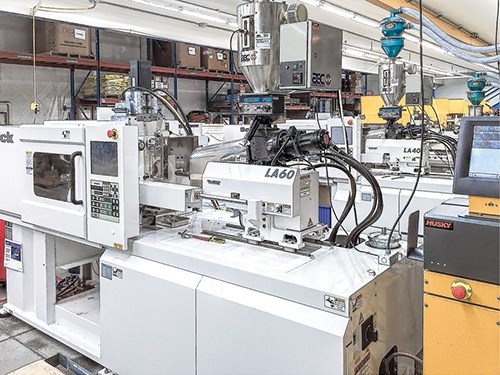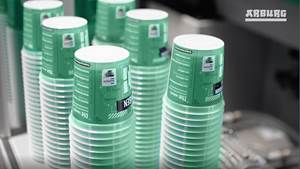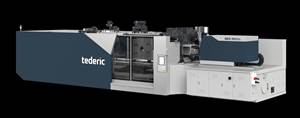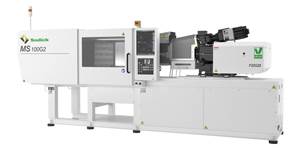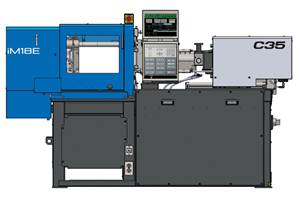Two-Stage Injection Meets Molder’s Need for High Precision
Fixed screw and plunger with no check ring hold tolerances of millionths of an inch.
A carpenter can’t do a proper job without the right tools, and the same goes for an injection molder. One essential tool for building contractors is a carpenter’s level, and molding critical parts for that device, it turns out, requires a special type of injection machine.
Empire Level in Mukwonago, Wis., is a leading designer and producer of levels, squares, and layout tools since 1919. A carpenter’s level may seem like a simple instrument, but manufacturing it is far from simple. Tom Foran, operations manager for plastics at Empire, notes that the vial with the “bubble” in a level is a cylinder of impact acrylic plus a cap.
They are molded, the vial is filled, the cap is welded on, and then the vial is decorated with the appropriate markings. Foran describes the inside of the vial as “football-shaped,” requiring ejection off an undercut. The internal arc in the vial has a 9-in. radius, with required accuracy of 0.0005 in./in.; and other tolerances on the 19/16–in.-long part are as small as ±60 millionths of an inch. The cap, which includes an energy director for ultrasonic welding, has tolerances of ±0.002 in.
The result, says process technician Chris Lathrop is “an extremely narrow process window for filling and packing.” Empire makes 18 million of the vial assemblies per year, using automatic cavity separation, and performs quality checks with a submicron coordinate measuring machine (CMM) and a vision system.
Using conventional horizontal injection machines, Empire Level had experienced unacceptably high internal reject rates. In 2014, the firm decided to purchase new presses. Foran was familiar with Sodick injection machines from Japan. Evaluating these presses against two other brands produced a clear conclusion: “The other competitors never stood a chance.”
The key was Sodick’s two-stage injection system, with a fixed screw feeding a plunger in a “V” arrangement. This eliminates the check valve that Foran considers to be the Achilles heel of most injection presses. Small differences in valve-closing time lead to variations in cushion volume, shot size, and fill rate. “The 0.1 sec it takes for a check ring to seal can make the difference between a good day of molding and a really bad one,” Foran comments.
He adds that with conventional presses, offgassing of the resin necessitated weekly teardowns for cleaning. But use of a non-reciprocating screw with no check valve has resulted in less shear on the resin and thus less offgassing and downtime for maintenance.
“An obstacle was the higher cost of this specialized machine,” Foran says. “But if you look at the entire package—the quality, accuracy, technical support, and training we received made it an easy decision. The machine essentially paid for itself in fewer rejects.
In August 2014, Empire Level bought two Sodick horizontal presses from Plustech, Inc., the North American branch of Sodick’s injection machine division, in Schaumburg, Ill. The press sizes were 40 tons with 14 cc shot size and 60 tons with 27 cc shot capacity. In October 2015, Empire added a Sodick 100-ton model with 251 cc shot size.
All three machines have a hybrid clamping system with servo-driven mold traverse, mechanical lock, and servo-hydraulic pump for mold closing and injection. Lathrop says servo-hydraulics have definite advantages, such as shorter valve reaction time (12 millisec) than for the all-electric presses Empire has examined.
Also, Lathrop says all-electrics “can’t handle the duty load of our process, which requires 20,000 psi fill pressure for 15-20 sec, and some products have long hold times.”
Related Content
Injection Compression Molding as Alternative to Thermoforming
Arburg will show its all-electric Allrounder 720 A press utilizing injection compression molding to create thin-wall IML cups from PP.
Read MoreTederic Promotes High Technology, Broader Market Presence
Four cells are running in its booth including a 1,300-ton multimaterial system highlighting its 2K capabilities.
Read MoreNext-Generation All-Electric and Vertical Injection Molding Machines
Sodick Plustech’s VR-G and MS-G2 Series both utilize the company’s proprietary V-Line technology, separating plasticizing and injection functions, and have upgraded displays, energy efficiency, response time and more.
Read MoreCompact Hybrid Injection Molding Machine Launched
Sumitomo Heavy Industries Ltd. (SHI) has introduced the iM18E, promising the smallest footprint in 20-ton machines.
Read MoreRead Next
Beyond Prototypes: 8 Ways the Plastics Industry Is Using 3D Printing
Plastics processors are finding applications for 3D printing around the plant and across the supply chain. Here are 8 examples to look for at NPE2024.
Read MoreFor PLASTICS' CEO Seaholm, NPE to Shine Light on Sustainability Successes
With advocacy, communication and sustainability as three main pillars, Seaholm leads a trade association to NPE that ‘is more active today than we have ever been.’
Read More


